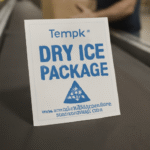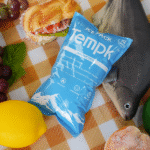How to Effectively Use Cold Chain Dry Ice Packs for Shipping Temperature-Sensitive Goods
Shipping perishable goods requires stringent temperature control, et cold chain dry ice packs are crucial for maintaining optimal conditions during transit. Cet article explique comment fonctionnent les packs de glace sec, leurs avantages, and how businesses can optimize their cold chain logistics to ensure efficient, rentable, and compliant shipping.
-
How do cold chain dry ice packs work and why are they so effective?
-
What are the best practices for using dry ice packs in shipping?
-
How can businesses optimize their cold chain logistics with dry ice?
What are Cold Chain Dry Ice Packs and How Do They Work?
Cold chain dry ice packs are solid carbon dioxide (Co₂) used to maintain extremely low temperatures during transit. Dry ice sublimes directly from solid to gas, providing effective cooling without leaving any liquid behind, Contrairement à la glace ordinaire. This makes dry ice ideal for shipping temperature-sensitive products such as vaccines, aliments surgelés, et des échantillons biologiques.
Pourquoi choisir la glace sèche pour l'expédition?
-
Performance de refroidissement supérieure: Dry ice keeps temperatures as low as -78.5°C (-109.3°F), ideal for shipping items requiring subzero temperatures.
-
No Residual Moisture: Contrairement à la glace traditionnelle, dry ice sublimates directly to gas, preventing moisture damage to goods.
-
Corparement pour l'expédition à longue distance: Dry ice can be more economical than refrigerated containers for international or remote shipments.
Best Practices for Using Cold Chain Dry Ice Packs
To optimize cold chain shipping, businesses should follow best practices for using dry ice:
-
Déterminez la bonne quantité de glace sèche: En général, 5 à 10 pounds of dry ice per 24 hours of shipping time works well. Adjust based on the product’s sensitivity and shipment duration.
-
Emballage approprié: Use high-quality insulated packaging to prolong the cooling effect. Materials like Styrofoam or Mylar bags are ideal for keeping the dry ice cold longer.
-
Surveillance de la température: Install temperature monitoring devices to ensure goods remain within the required temperature range throughout the shipping process.
-
Correct Labeling: Always label packages with the proper “Dioxyde de carbone solide” label to ensure safe handling by transport staff.
How to Optimize Your Cold Chain Logistics with Dry Ice
Optimizing cold chain logistics can improve efficiency, réduire la détérioration, and cut costs. Here’s how to streamline your dry ice shipping process:
-
Analyze Historical Shipping Data: Use past shipment data to calculate the right amount of dry ice for future shipments.
-
Insulate Shipments Properly: Using the best insulated containers will extend dry ice life and prevent early sublimation.
-
Leverage Technology: Invest in AI-powered logistics platforms to optimize dry ice usage and automate calculations based on variables like shipment size, température, and duration.
| Shipping Factor | Recommended Practice | Pourquoi ça compte |
|---|---|---|
| Quantité de glace sèche | Utiliser 5-10 lbs par 24 heures d'expédition | Keeps products within required temperatures |
| Matériau d'emballage | Use insulated packaging like Styrofoam | Extends the cooling period of dry ice |
| Surveillance de la température | Install temperature trackers | Ensures compliance with temperature requirements |
Comment gérer la glace sèche en toute sécurité
Handling dry ice with care is essential for safe and efficient shipping:
-
Porter des gants: Always wear insulated gloves when handling dry ice to avoid frostbite or cold burns.
-
Assurer une bonne ventilation: La glace sèche sublime dans le gaz co₂, so it’s crucial to handle it in well-ventilated spaces to avoid gas buildup.
-
Disposition appropriée: Allow dry ice to sublimate in a ventilated area before disposal to avoid hazardous CO₂ accumulation.
Real-Life Case: A pharmaceutical company shipped temperature-sensitive vaccines using dry ice, ensuring zero spoilage by adhering to packing and monitoring procedures, enhancing logistics reliability.
Trends in Cold Chain Dry Ice Shipping for 2025
À mesure que le secteur logistique de la chaîne froide évolue, new trends are emerging, particularly around sustainability and technology.
Sustainable Solutions in Dry Ice Shipping
Eco-friendly dry ice packaging, including biodegradable insulation materials, is becoming more common as businesses aim to reduce their carbon footprint. En plus, capturing CO₂ from renewable sources for dry ice production is being explored to minimize environmental impact.
Solutions d'emballage intelligents
The integration of IoT-enabled sensors into packaging allows for real-time temperature and humidity monitoring, reducing waste and improving shipment accuracy.
Automatisation dans la logistique de la chaîne du froid
Automation is enhancing efficiency in cold chain logistics, with robotic systems handling packing, étiquetage, and inventory management to reduce human error.
Questions fréquemment posées
Q1: How long does a cold chain dry ice pack last?
A properly insulated dry ice pack can maintain freezing temperatures for 24–48 hours, depending on insulation quality and ambient conditions.
Q2: Is dry ice safe for shipping food?
Oui, dry ice is made from non-toxic CO₂ and is safe for food contact, but be sure to place a barrier between the dry ice and sensitive products to prevent freezer burn.
Q3: La glace sèche peut-elle être réutilisée?
Non, dry ice sublimates completely and cannot be reused. Cependant, alternatives like gel packs can be refrozen and reused multiple times.
Résumé et recommandations
Cold chain dry ice packs are essential for shipping temperature-sensitive goods safely and efficiently. By following best practices like proper packaging, surveillance de la température, and safety guidelines, businesses can ensure their shipments remain intact throughout transit.
Actionable Suggestions:
-
Audit Your Shipments: Determine which products require dry ice and ensure you are using the correct amount.
-
Review Regulatory Compliance: Ensure your processes adhere to current regulations like IATA PI 954 and UN 1845.
-
Invest in Monitoring: Use IoT sensors or data loggers for real-time tracking of temperature and location during shipment.
À propos du tempk
Tempk se spécialise dans la fourniture de solutions de logistique de chaîne du froid innovantes, including premium dry ice packs, designed to keep your temperature-sensitive products at the optimal temperature. With extensive industry experience, we help businesses reduce spoilage and improve shipping reliability.
Appel à l'action: Reach out to Tempk for personalized guidance on optimizing your cold chain shipping practices and ensuring your products arrive safely.
























